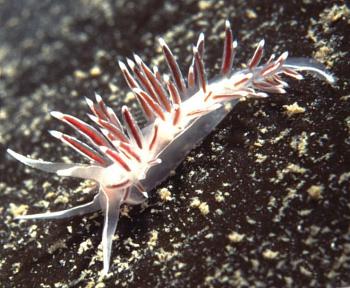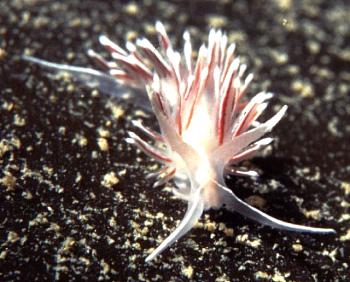

Flabellina lineata
(Loven, 1846)
Order: NUDIBRANCHIA
Suborder: AEOLIDINA
Family: Flabellinidae
DISTRIBUTION
Westerm Mediterranean and Atantic coast of Europe to Norway.
PHOTO
Trebeurden, Brittany, France, June 1995. Photos: Peter van Bragt.
Oral tentacles have a white longitudinal line which continues down on to the head. The two lines join to form a median line running down the body to the posterior tip of the foot. The smooth rhinophores are white-tipped with a white streak posteriorly. There is also a white line along each side of the body below the cerata. The digestive gland duct ranges in colour from dark reddish brown to bright red. There is usuually a white subapical band on the cerata and can be a white line down the anterior and posterior sides of each ceras, but often only parts of these lines are present. It is reported to feed on a variety of hydroids. Can grow to 50mm long.
Reference:
• Lovén, S.L. (1846). Index molluscorum litora Scandinaviae Occidentalia habitantium. Ofvers K. Vet. Akad. Forh. Stockholm, 3: 135-160 (Nudibranchia p. 136-140)
Rudman, W.B., 2000 (September 17) Flabellina lineata (Loven, 1846). [In] Sea Slug Forum. Australian Museum, Sydney. Available from http://www.seaslugforum.net/find/flabline
Related messages
Re: Flabellina lineata from France
March 6, 2008
From: Dominique Horst


Concerning message #3003:
Hello Bill,
This should be Flabellina lineata.
It's more than two years since I first found this species. In my last two dives a friend of mine shot two different individuals which have a very different colour.
As with Janolus cristatus, could this colour variation be explained by what the slug feed on?
Locality: Antibes Cape, 14m, France, Mediterranean sea, 03 March 2008. Length: 20mm. Photographer: Dominique Horst (upper photo), Yves Louis (lower photo).
Kind regards,
Dom.
dominique.horst@wanadoo.fr
Horst, D., 2008 (Mar 6) Re: Flabellina lineata from France. [Message in] Sea Slug Forum. Australian Museum, Sydney. Available from http://www.seaslugforum.net/find/21420
Dear Dom,
Yes the colour difference is almost certainly food related. In aeolids the 'food processing' organ or digestive gland is found not in the body cavity but up in the branches of the cerata, and the colour of the digestive gland quickly takes on the colour of the food it is processing. If you look at the Favorinus japonicus Fact Sheet you will see an animal in the process of changing colour as it moves from pink to green food. In the close-up alongside you can see the organs in the body of the Flabellina are pale pink while those in the cerata are red. This reflects the different organs - in the body cavity the tissue you can see is almost exclusively gonads -ovary, testes - whicle in the cerata it is digestive gland and ingested food.
Best wishes,
Bill Rudman
Flabellina lineata from Scotland
May 25, 2005
From: Jim Anderson

Dear Bill,
We observed many (dozens) of these Flabellina lineata on Sunday during 2 dives. They ranged from 25 metres up to 9 metres. The water temp was approx 10 deg C. There were also many more spawn masses visible. The animals were all large 35 -55 mm long approx. compared with much smaller animals seen the week previously at a site 50 miles from here.
Locality: Kenmore Point, Loch Fyne, Scotland (Sea Loch on west coast of Scotland). Depth: 9 - 25 metres. Length: 40 mm.16 May 2005. on cliff and boulders. Photographer: Jim Anderson
Best wishes,
Jim Anderson
jander4454@gmail.com


Thanks Jim,
These animals certainly prove how wrong it is to think that beautiful nudibranchs are only found in tropical waters.
Best wishes,
Bill Rudman
Flabellina lineata at Loch Etive, Scotland
August 16, 2003
From: Jim Anderson

Dear Bill,
Here are some images of Flabellina lineata taken during a recent dive, 10 August 2003, and shows a pair mating. The dive was at Rubh'aird Phlacaig on the north shore of Loch Etive on the west coast of Scotland.
The animals were found at 12.2 metres and the water temp was 12 deg C. The larger animal approx. 50mm long which puts it at the top end of the animals size range I believe. This pair were found with along with several others (approx. 12 over 2 sq. M?) with other isolated specimens and small groups of 2 or 3 encountered at different depths (10-20 m) during this and the preceding dive that day. All of the animals were big (40 - 50mm), something I have observed before with this species in this Loch on previous 10 dives over the last 3 years, but not elsewhere. There usual size range is 15 - 25mm.
Loch Etive is unusual in that is a long narrow loch with 4 deep basins separated by narrow shallow sills leading to low levels of salinity, in the surface layers where I've been, and low light levels due to the peat washed into the loch from the surrounding hills. The site where these animals were located is approx. 16 nautical miles from the outermost sill near the sea and the basin drops to over 100 m depth - the sill between it and the next one nearer to the sea is only 6 m deep. There will be a low turnover of water and larvae in and out of these basins and I wonder whether the large size could be a local variation as a consequence. I know that my limited observations are hardly scientific but I keep coming back to the question why so many big animals in this inner basin and not elsewhere. It might interest someone with the skills and energy to investigate further or am I just getting carried away after what was a very lucky and exciting observation of the animals mating behaviour?
Kind regards,
Jim Anderson
JAnder4454@aol.com


Dear Jim,
Thanks for these interesting observations. If the large animals represent a 'genetically distinct' population you might expect they would not mate until they reached a larger than normal size. Your photo showing the small animal mating with the large animal suggests otherwise. My feeling with these large animals is that they are either eating and growing much faster than normal - due to an overabundance of food, or else they are living much longer than normal - perhaps due to a constant availability of food. Perhaps the nature of the fjord-like environment is conducive to lush and reliable growth of the hydroids this species eats throughout the year?
But as you say these things need proper investigation. A study of populations in these Scottish fjords would indeed be an interesting and hopefully rewarding study for a student.
Best wishes,
Bill Rudman
Flabellina lineata from France
September 24, 2000
From: Peter H. van Bragt


Hallo Bill
Please link these data and images to the records of the Netherlands.
Enclosed you will find two images of Coryphella lineata. Both photographs
were made near Trebeurden (Bretagne, France) in June 1995.
This nudi is very rare in the Netherlands. So far it was only found twice. Once in 1954 washed ashore on a buoy and once in 1970 far out on the North Sea. As it is a common species on the European atlantic coast there is a fair chance that it will be found again on the Dutch coast in the near future. We'll keep you informed.
Best regards
Peter H. van Bragt
vanbragt.phjm@hsbrabant.nl
van Bragt , P.H., 2000 (Sep 24) Flabellina lineata from France. [Message in] Sea Slug Forum. Australian Museum, Sydney. Available from http://www.seaslugforum.net/find/3003Dear Peter,
To prevent confusion I have changed to genus name you are using from Coryphella to Flabellina. I think all nudbranch taxonomists now consider Coryphella to be a synonym of Flabellina. I wish you luck in finding specimens of this species in the Netherlands.
Best wishes,
Bill Rudman.
